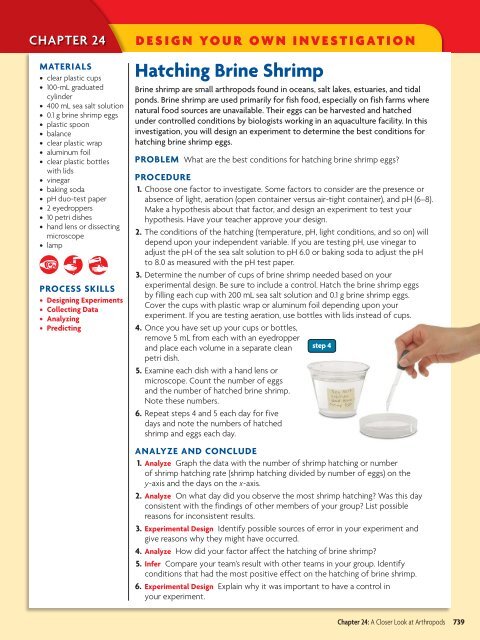24 A Closer Look at Arthropods
24 A Closer Look at Arthropods
24 A Closer Look at Arthropods
You also want an ePaper? Increase the reach of your titles
YUMPU automatically turns print PDFs into web optimized ePapers that Google loves.
CHAPTER <strong>24</strong><br />
MATERIALS<br />
• clear plastic cups<br />
• 100-mL gradu<strong>at</strong>ed<br />
cylinder<br />
• 400 mL sea salt solution<br />
• 0.1 g brine shrimp eggs<br />
• plastic spoon<br />
• balance<br />
• clear plastic wrap<br />
• aluminum foil<br />
• clear plastic bottles<br />
with lids<br />
• vinegar<br />
• baking soda<br />
• pH duo-test paper<br />
• 2 eyedroppers<br />
• 10 petri dishes<br />
• hand lens or dissecting<br />
microscope<br />
• lamp<br />
PROCESS SKILLS<br />
• Designing Experiments<br />
• Collecting D<strong>at</strong>a<br />
• Analyzing<br />
• Predicting<br />
DESIGN YOUR OWN INVESTIGATION<br />
H<strong>at</strong>ching Brine Shrimp<br />
Brine shrimp are small arthropods found in oceans, salt lakes, estuaries, and tidal<br />
ponds. Brine shrimp are used primarily for fish food, especially on fish farms where<br />
n<strong>at</strong>ural food sources are unavailable. Their eggs can be harvested and h<strong>at</strong>ched<br />
under controlled conditions by biologists working in an aquaculture facility. In this<br />
investig<strong>at</strong>ion, you will design an experiment to determine the best conditions for<br />
h<strong>at</strong>ching brine shrimp eggs.<br />
PROBLEM Wh<strong>at</strong> are the best conditions for h<strong>at</strong>ching brine shrimp eggs?<br />
PROCEDURE<br />
1. Choose one factor to investig<strong>at</strong>e. Some factors to consider are the presence or<br />
absence of light, aer<strong>at</strong>ion (open container versus air-tight container), and pH (6–8).<br />
Make a hypothesis about th<strong>at</strong> factor, and design an experiment to test your<br />
hypothesis. Have your teacher approve your design.<br />
2. The conditions of the h<strong>at</strong>ching (temper<strong>at</strong>ure, pH, light conditions, and so on) will<br />
depend upon your independent variable. If you are testing pH, use vinegar to<br />
adjust the pH of the sea salt solution to pH 6.0 or baking soda to adjust the pH<br />
to 8.0 as measured with the pH test paper.<br />
3. Determine the number of cups of brine shrimp needed based on your<br />
experimental design. Be sure to include a control. H<strong>at</strong>ch the brine shrimp eggs<br />
by filling each cup with 200 mL sea salt solution and 0.1 g brine shrimp eggs.<br />
Cover the cups with plastic wrap or aluminum foil depending upon your<br />
experiment. If you are testing aer<strong>at</strong>ion, use bottles with lids instead of cups.<br />
4. Once you have set up your cups or bottles,<br />
remove 5 mL from each with an eyedropper<br />
and place each volume in a separ<strong>at</strong>e clean step 4<br />
petri dish.<br />
5. Examine each dish with a hand lens or<br />
microscope. Count the number of eggs<br />
and the number of h<strong>at</strong>ched brine shrimp.<br />
Note these numbers.<br />
6. Repe<strong>at</strong> steps 4 and 5 each day for five<br />
days and note the numbers of h<strong>at</strong>ched<br />
shrimp and eggs each day.<br />
ANALYZE AND CONCLUDE<br />
1. Analyze Graph the d<strong>at</strong>a with the number of shrimp h<strong>at</strong>ching or number<br />
of shrimp h<strong>at</strong>ching r<strong>at</strong>e (shrimp h<strong>at</strong>ching divided by number of eggs) on the<br />
y-axis and the days on the x-axis.<br />
2. Analyze On wh<strong>at</strong> day did you observe the most shrimp h<strong>at</strong>ching? Was this day<br />
consistent with the findings of other members of your group? List possible<br />
reasons for inconsistent results.<br />
3. Experimental Design Identify possible sources of error in your experiment and<br />
give reasons why they might have occurred.<br />
4. Analyze How did your factor affect the h<strong>at</strong>ching of brine shrimp?<br />
5. Infer Compare your team’s result with other teams in your group. Identify<br />
conditions th<strong>at</strong> had the most positive effect on the h<strong>at</strong>ching of brine shrimp.<br />
6. Experimental Design Explain why it was important to have a control in<br />
your experiment.<br />
Chapter <strong>24</strong>: A <strong>Closer</strong> <strong>Look</strong> <strong>at</strong> <strong>Arthropods</strong> 739

















